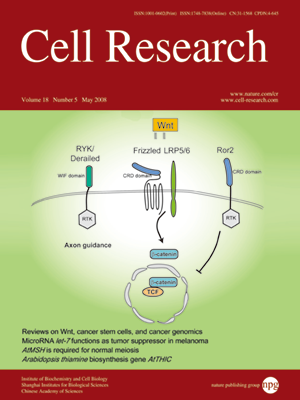
Volume 18, No 5, May 2008
ISSN: 1001-0602
EISSN: 1748-7838 2018
impact factor 17.848*
(Clarivate Analytics, 2019)
Volume 18 Issue 5, May 2008: 566-576
ORIGINAL ARTICLES
AtTHIC, a gene involved in thiamine biosynthesis in Arabidopsis thaliana
Danyu Kong1,2,*, Yuxing Zhu1,2,*, Huilan Wu1, Xudong Cheng1,2, Hui Liang1 and Hong-Qing Ling1
1The State Key Laboratory of Plant Cell and Chromosome Engineering, National Center for Plant Gene Research, Institute of Genetics and Developmental Biology, Chinese Academy of Sciences, Datun Road, Chaoyang District, Beijing 100101, China
2Graduate University of the Chinese Academy of Sciences, 19 Yuquan Road, Shijingshan District, Beijing 100049, China
Correspondence: Hong-Qing Ling(hqling@genetics.ac.cn )
Thiamine (vitamin B
1) is an essential compound for organisms. It contains a pyrimidine ring structure and a thiazole ring structure. These two moieties of thiamine are synthesized independently and then coupled together. Here we report the molecular characterization of AtTHIC, which is involved in thiamine biosynthesis in
Arabidopsis. AtTHIC is similar to
Escherichia coli ThiC, which is involved in pyrimidine biosynthesis in prokaryotes. Heterologous expression of
AtTHIC could functionally complement the
thiC knock-out mutant of
E. coli. Downregulation of
AtTHIC expression by T-DNA insertion at its promoter region resulted in a drastic reduction of thiamine content in plants and the knock-down mutant
thic1 showed albino (white leaves) and lethal phenotypes under the normal culture conditions. The
thic1 mutant could be rescued by supplementation of thiamine and its defect functions could be complemented by expression of
AtTHIC cDNA. Transient expression analysis revealed that the AtTHIC protein targets plastids and chloroplasts.
AtTHIC was strongly expressed in leaves, flowers and siliques and the transcription of
AtTHIC was downregulated by extrinsic thiamine. In conclusion,
AtTHIC is a gene involved in pyrimidine synthesis in the thiamine biosynthesis pathway of
Arabidopsis, and our results provide some new clues for elucidating the pathway of thiamine biosynthesis in plants.
Cell Research (2008) 18:566-576. doi: 10.1038/cr.2008.35; published online 11 March 2008
FULL TEXT | PDF
Browse 1896


